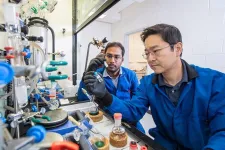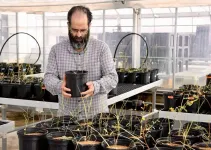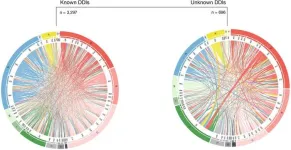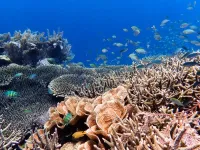(Press-News.org) The modern world is filled with synthetic polymers, long-chained molecules designed by scientists to fill all manner of applications.
Researchers at FAMU-FSU College of Engineering have developed two closely related polymers that respond differently to high and low temperature thresholds, despite their similar design. The polymer pair could be used in applications in medicine, protein synthesis, protective coatings and other fields. Their work is published in Macromolecules.
“Typically, in order to have one thermal behavior, we have to prepare a polymer for that specific application, and if you want to have another extreme of polymer behavior, then you have to prepare a completely different polymer,” said coauthor Hoyong Chung, an associate professor in the FAMU-FSU College of Engineering. “But now, through this work, we have a single type of polymer that can be quickly adapted with minimal interference for both jobs.”
The researchers’ polymer is made with sulfoxide, a compound made of sulfur, oxygen and carbon molecules. One version contains an extra ingredient, a pair of hydrogen atoms known as a methylene group. This small structural variation is enough for each polymer to respond differently to variations in temperature.
Every mixture has critical temperatures above or below which the components will completely dissolve into a solution, regardless of the concentration of the various components in the mixture.
One version of the researchers’ polymer is soluble in water at low temperatures but becomes insoluble at higher temperatures. The other version displays the opposite behavior. It is insoluble at lower temperatures but dissolves when temperatures rise above a critical point.
“This contrasting behavior, which appeared with just a single minor change, was a surprising finding,” said postdoctoral researcher Biswajit Saha, the paper’s lead author. “It’s an exciting avenue for future research.”
Along with their development of this new, temperature-controllable polymer, the research team made other discoveries:
A new mechanism that governs a critical temperature threshold: Previous research showed that hydrogen atom bonds determined the temperature above which temperature-sensitive polymers dissolved in a solution, the so-called upper critical solution threshold. But Chung’s group found that the attraction between positively and negatively charged poles of different molecules — a process known as dipole-dipole interaction — also predicted the temperature at which their polymer would mix in water. Notably, his group has experimentally proved the presence of this interaction as a driving force of the thermal behavior.
Two-stage thermal behavior: Most solutions experience a single-phase change when they pass their temperature threshold. But the polymer developed by Chung’s team goes through phase changes in two stages. This feature could open potential new applications in medicine, such as a single medicine capsule that dissolves in the heat of a patient’s stomach in two stages, allowing for precise medicine delivery.
“We were fortunate to have these various insights with a single design,” Chung said. “A single polymer that can be ‘programmed’ to achieve different behaviors means this molecule can be easily adapted to different applications.”
This research was supported by the National Science Foundation.
END
Two in one: FSU researchers develop polymer that can be adapted to high and low temperature extremes
2023-09-07
ELSE PRESS RELEASES FROM THIS DATE:
New stroke treatment in development at UTHSC
2023-09-07
A study at the University of Tennessee Health Science Center aims to develop a new way to treat ischemic stroke, a leading cause of death in adults worldwide.
The study is funded by a $1,155,000 translational grant from the National Institute of Neurological Disorders and Stroke, part of the National Institutes of Health. Jianxiong Jiang, PhD, associate professor in the Department of Pharmaceutical Sciences and the Department of Anatomy and Neurobiology, and Jiawang Liu, PhD, director of the Medicinal Chemistry ...
New study reveals the power of railroads to buffer coal plants from a carbon emissions tax
2023-09-07
A new study by University of Maryland Economist Louis Preonas provides empirical evidence that railroads are likely to cut transportation prices to prop up coal-fired plants if U.S. climate policies further disadvantage coal in favor of less carbon-intensive energy sources.
One strategy being considered to help reduce the country’s contribution to global climate change is a tax or fee on greenhouse gas emissions by coal-burning power plants. The hope is that such fees will reduce competitiveness of coal-fired energy and consumers will chose lower-emission options at a competitive cost. The new study, published September 7, 2023, in The ...
Mount Sinai scientists unlock secrets of red blood cell transporter, potentially paving the way for new drugs
2023-09-07
New York, NY (September 7, 2023)—Researchers at the Icahn School of Medicine at Mount Sinai have identified the structure of a special transporter found in red blood cells and how it interacts with drugs. Details on the findings, which were reported in the September 7 issue of Nature Structural & Molecular Biology [DOI: 10.1038/s41594-023-01085-6], could lead to the development of more targeted medicines.
The research team, led by Daniel Wacker, PhD, Bin Zhang, PhD, and Avner Schlessinger, PhD, found that this transporter facilitates ...
Research spotlight: History of Adverse Childhood Events (ACEs) linked to increased risk of head or neck injury and concussion
2023-09-07
Altaf Saadi, MD, MSc, principal investigator of the Neurodisparities & Health Justice Lab in the Department of Neurology at Mass General and an assistant professor of Neurology at Harvard Medical School, is lead author of a new study in the Journal of Head Trauma and Rehabilitation, Examining the Association Between Adverse Childhood Experiences and Lifetime History of Head or Neck Injury or Concussion in Children From the United States.
What Question Were You Investigating?
Is there an association between adverse childhood experiences ...
University of Houston researcher aids in creation of groundbreaking report on invasive species
2023-09-07
A new report by the Intergovernmental Platform on Biodiversity and Ecosystem Services (IPBES) presents major findings on the gravity of impacts from invasive alien species on our planet. Researchers found more than 37,000 alien species have been introduced by human activities over the centuries, and this conservative estimate is rising at unprecedented rates. Additionally, more than 3,500 of these are harmful invasive alien species, impacting humans, animals and plants.
Dozens of international biodiversity ...
CAR-T-cell therapy without side effects? Hollings researchers show results in preclinical models
2023-09-07
When Richard O’Neil, Ph.D., joined MUSC Hollings Cancer Center two years ago, he knew that he wanted to continue finding ways to make CAR-T-cell therapy easier on patients.
What he didn’t expect was that a side project – worked on by Megan Tennant, a graduate student in his lab, as a way to keep busy while a key piece of equipment was being serviced – would potentially open up this treatment beyond the world of cancer.
“I don't think that either of us expected that first initial experiment to work,” Tennant said. “But when we saw how well it worked and really started to conceptualize where this could go and how important ...
The timing of fireworks-caused wildfire ignitions during the 4th of July holiday season
2023-09-07
Every year on the 4th of July, fireworks cause cause a precipitous increase of wildfire ignitions in the United States (U.S.). This human-environmental phenomenon is noteworthy and highlights the impact of American culture on wildfire activity in the U.S. In other regions of the world, research has increasingly shown that human culture impacts fire activity, with weekly cycles of fire activity reflecting the local structures of workweeks and the timing of religious days of rest (e.g., Saturdays and Sundays). Although 4th of July peak in wildfire igntions has ...
Dosage tweaks may hint at undiscovered interactions between medications
2023-09-07
Analysis of data from more than 1 million Danish inpatients identifies nearly 4,000 drug pairings that are associated with more frequent dosage adjustments when prescribed together—potentially hinting at previously undiscovered drug interactions. Søren Brunak of the University of Copenhagen, Denmark, and colleagues present these findings in the open-access journal PLOS Digital Health.
In some cases, especially among elderly populations, a person may be prescribed several different medications at once in order to treat one or multiple health conditions—a phenomenon known as polypharmacy. Polypharmacy is associated with increased health risks due to the potential ...
How bright-light treatment improves sleep in stressed mice
2023-09-07
Chronic stress is associated with sleep disturbance. In their new study, Lu Huang and colleagues identify the neural pathway behind this behavior, and at the same time, explain how bright-light treatment is able to counter it. The research was conducted in mice at Jinan University in China and published September 7th in the open access journal PLOS Biology.
Bright-light treatment is known to improve sleep in those with sleep disorders, but how it works – and whether it works in cases of stress-induced sleep disturbances – was unknown. The researchers hypothesized that a part of the brain called the lateral habenula is deeply involved in this phenomenon because ...
Lack of evidence hampers progress on corporate-led ecosystem restoration
2023-09-07
A ‘near total’ lack of transparency is making it impossible to assess the quality of corporate-led ecosystem restoration projects, according to a Lancaster University-led study published today in Science.
Efforts to rebuild degraded environments are vital for achieving global biodiversity targets. The United Nations has launched a Decade on Ecosystem Restoration, and in recent years businesses around the world have collectively pledged to plant billions of trees, hundreds of thousands of corals and tens of ...







